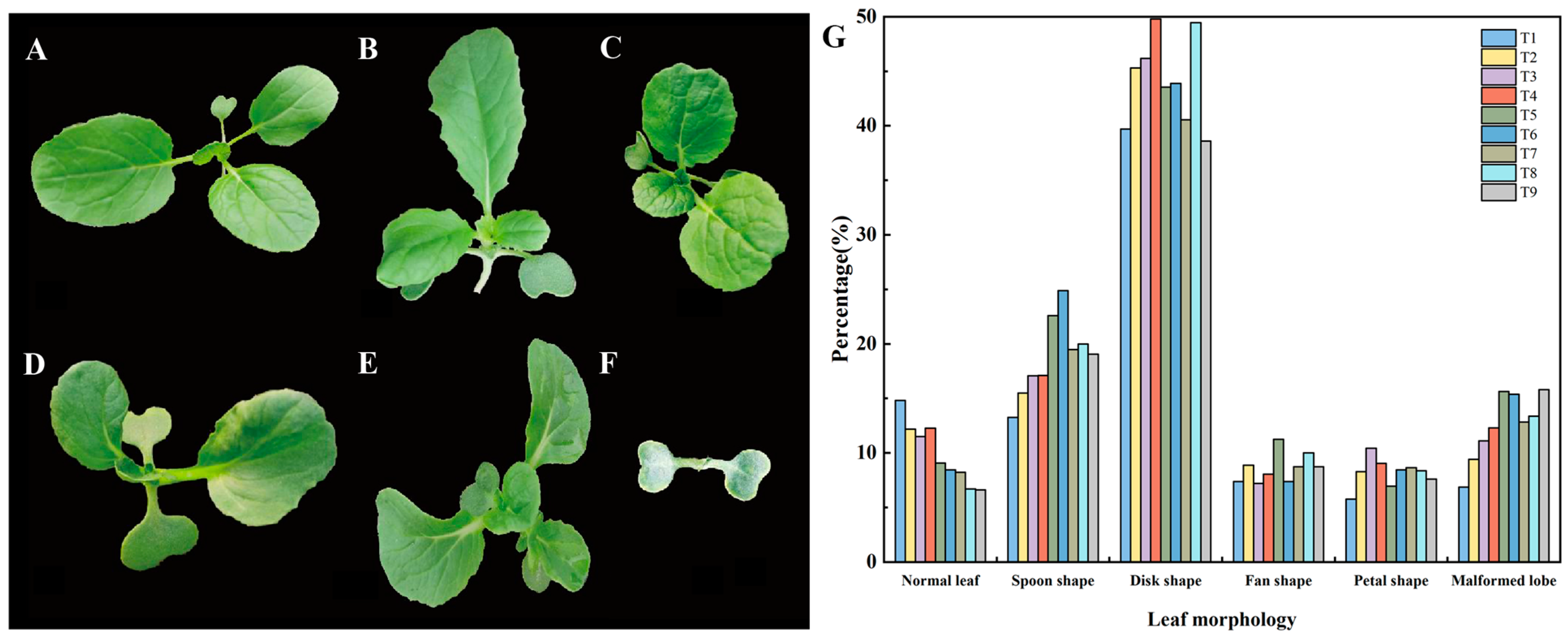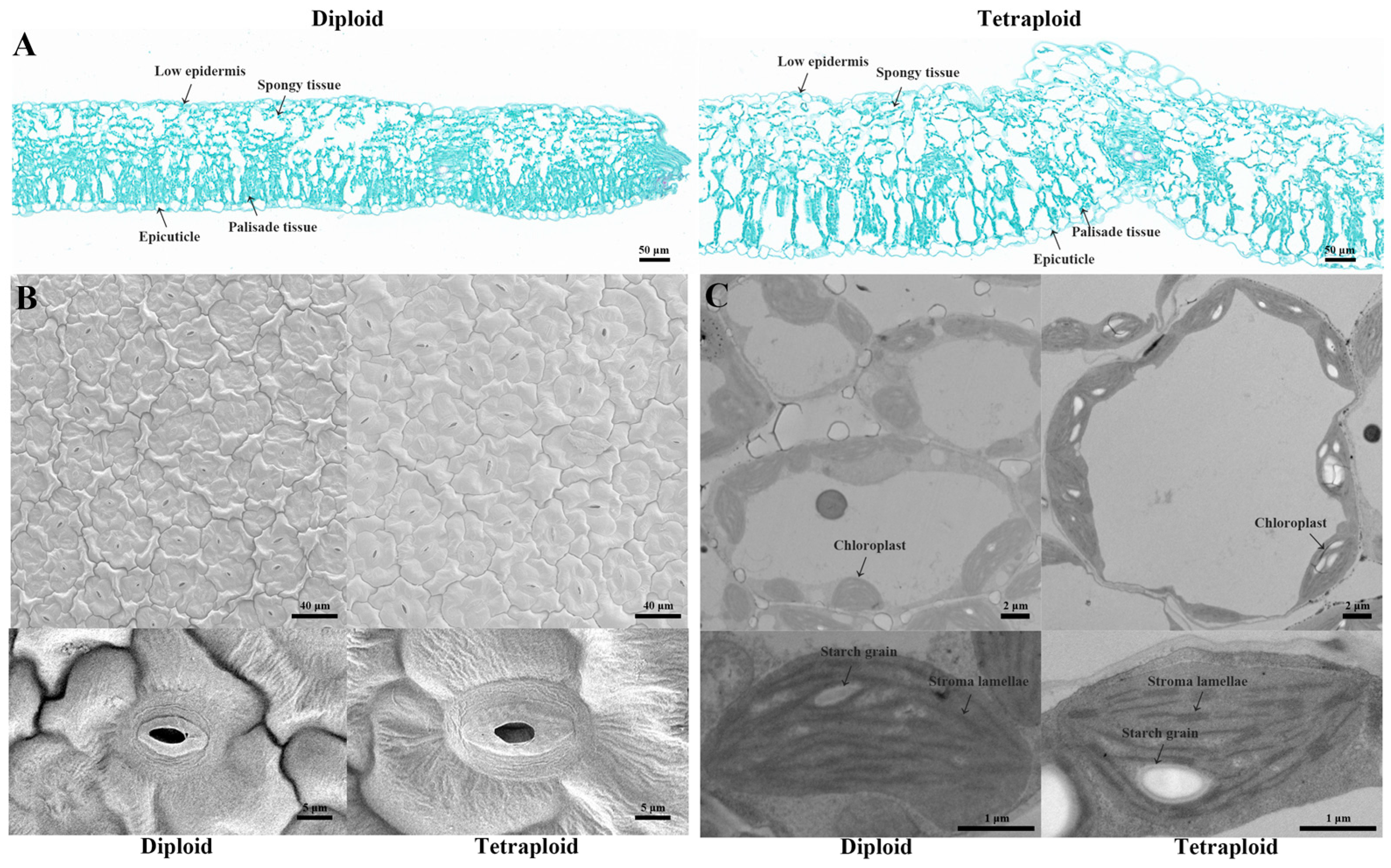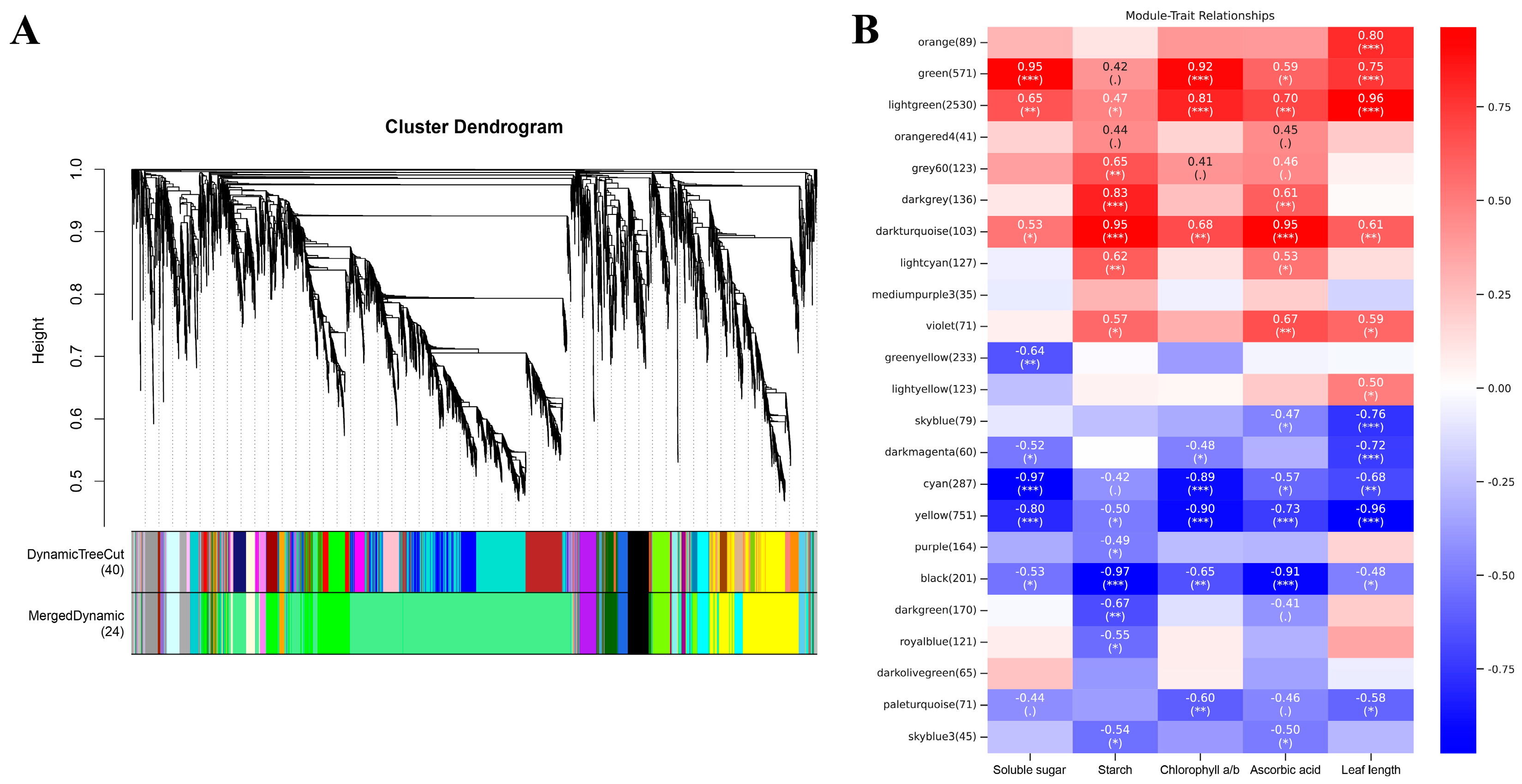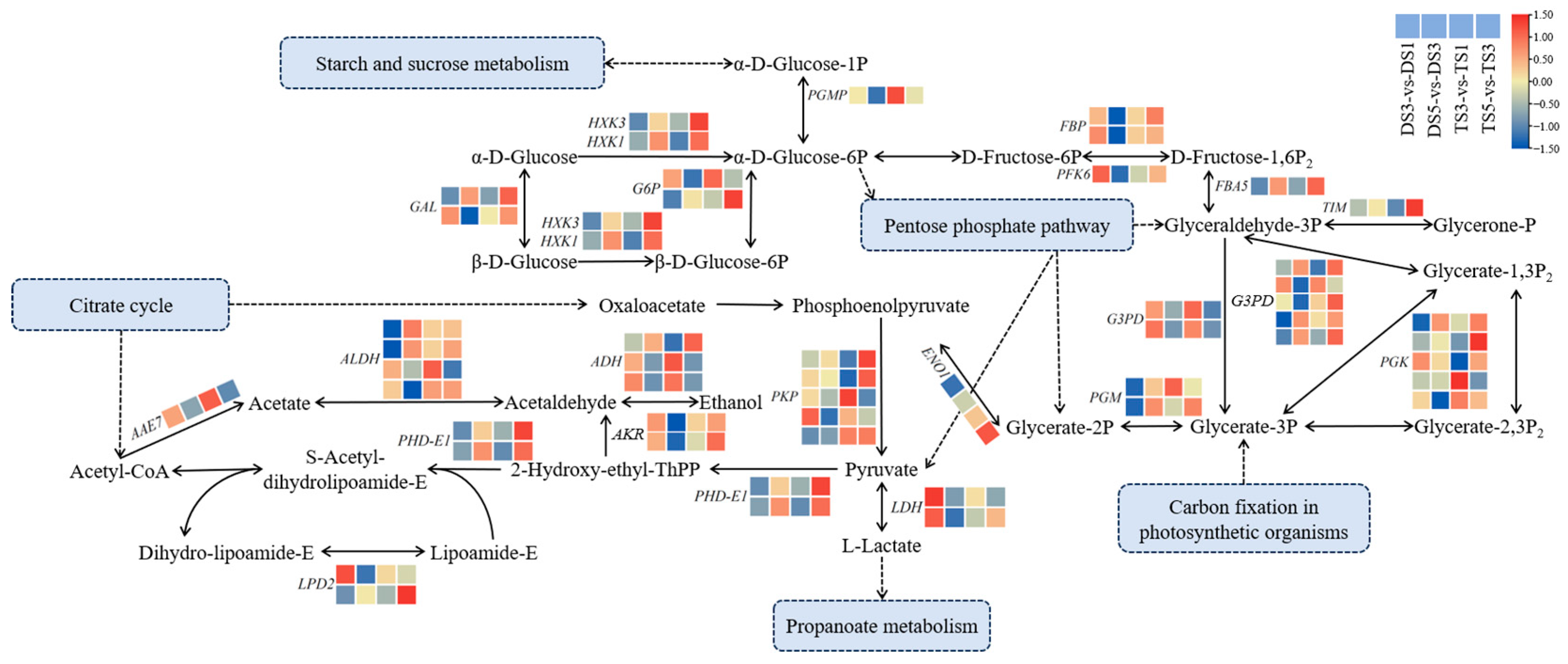Comparative Morphological, Physiological, and Transcriptomic Analyses of Diploid and Tetraploid Wucai (Brassica campestris L.)
Abstract
1. Introduction
2. Results
2.1. Identification of Diploid and Tetraploid Wucai Lines
2.2. Identification of Autotetraploid Wucai
2.3. Anatomy and Microstructure of Tetraploid Wucai
2.4. Photosynthetic Differences between Diploid and Tetraploid Wucai
2.5. Comparison of Nutritional Quality between Diploid and Tetraploid Wucai
2.6. Transcriptomic Comparison between Diploid and Tetraploid Wucai at Different Developmental Stages
2.7. Functional Analysis of Differentially Expressed Genes
2.8. Weighted Gene Co-Expression Network Analysis (WGCNA)
2.9. Glycolysis Pathway Involved in Ploidy Development
3. Discussion
4. Materials and Methods
4.1. Establishing Autotetraploid Wucai Lines
4.2. Ploidy Analysis
4.3. Morphological and Microscopic Observation
4.4. Analysis of Photosynthetic Pigments and Chlorophyll Fluorescence Parameters
4.5. Evaluation of Physiological Indicators
4.6. RNA Sequencing and Transcriptomic Analysis
4.7. Weighted Gene Co-Expression Network Analysis
4.8. Quantitative Real-Time PCR Validation
Supplementary Materials
Author Contributions
Funding
Data Availability Statement
Conflicts of Interest
References
- Guo, L.Y.; Wang, S.; Jiao, X.; Ye, X.X.; Deng, D.Y.; Liu, H.; Li, Y.; van de Peer, Y.; Wu, W.W. Convergent and/or parallel evolution of RNA-binding proteins in angiosperms after polyploidization. New Phytol. 2024, 242, 1377–1393. [Google Scholar] [CrossRef]
- Soltis, D.E.; Soltis, P.S.; Tate, J.A. Advances in the study of polyploidy since Plant speciation. New Phytol. 2004, 161, 173–191. [Google Scholar] [CrossRef]
- Mable, B.K.; Alexandrou, M.A.; Taylor, M.I. Genome duplication in amphibians and fish: An extended synthesis. J. Zool. 2011, 284, 151–182. [Google Scholar] [CrossRef]
- Otto, S.P.; Whitton, J. Polyploid incidence and evolution. Annu. Rev. Genet. 2000, 34, 401–437. [Google Scholar] [CrossRef] [PubMed]
- Chen, Z.J. Genetic and epigenetic mechanisms for gene expression and phenotypic variation in plant polyploids. Annu. Rev. Plant Biol. 2007, 58, 377–406. [Google Scholar] [CrossRef]
- Masterson, J. Stomatal size in fossil plants: Evidence for polyploidy in majority of angiosperms. Science 1994, 264, 421–424. [Google Scholar] [CrossRef]
- Xu, X.; Pan, S.K.; Cheng, S.F.; Zhang, B.; Mu, D.S.; Ni, P.X.; Zhang, G.Y.; Yang, S.; Li, R.Q.; Wang, J.; et al. Genome sequence and analysis of the tuber crop potato. Nature 2011, 475, 189–194. [Google Scholar]
- D’Hont, A.; Denoeud, F.; Aury, J.M.; Baurens, F.C.; Carreel, F.; Garsmeur, O.; Noel, B.; Bocs, S.; Droc, G.; Rouard, M.; et al. The banana (Musa acuminat) genome and the evolution of monocotyledonous plants. Nature 2012, 488, 213–217. [Google Scholar] [CrossRef]
- Marcussen, T.; Sandve, S.R.; Heier, L.; Spannagl, M.; Pfeifer, M.; Jakobsen, K.S.; Wulff, B.B.H.; Steuernagel, B.; Mayer, K.F.X.; Olsen, O.A.; et al. Ancient hybridizations among the ancestral genomes of bread wheat. Science 2014, 345, 125009. [Google Scholar] [CrossRef]
- Zhang, T.Z.; Hu, Y.; Jiang, W.K.; Fang, L.; Guan, X.Y.; Chen, J.D.; Zhang, J.B.; Saski, C.A.; Scheffler, B.E.; Stelly, D.M.; et al. Sequencing of allotetraploid cotton (Gossypium hirsutum L. acc. TM-1) provides a resource for fiber improvement. Nat. Biotechnol. 2015, 33, 531–537. [Google Scholar] [CrossRef]
- Renny-Byfield, S.; Wendel, J.F. Doubling down on genomes: Polyploidy and crop plants. Am. J. Bot. 2014, 101, 1711–1725. [Google Scholar] [CrossRef] [PubMed]
- Abel, S.; Becker, H.C. The effect of autopolyploidy on biomass production in homozygous lines of Brassica rapa and Brassica oleracea. Plant Breed. 2007, 126, 642–643. [Google Scholar] [CrossRef]
- Tan, F.Q.; Tu, H.; Liang, W.J.; Long, J.M.; Wu, X.M.; Zhang, H.Y.; Guo, W.W. Comparative metabolic and transcriptional analysis of a doubled diploid and its diploid citrus rootstock (C. junos cv. Ziyang xiangcheng) suggests its potential value for stress resistance improvement. BMC Plant Biol. 2015, 15, 89. [Google Scholar] [CrossRef] [PubMed]
- Chen, Y.Y.; Xu, H.W.; He, T.; Gao, R.H.; Guo, G.M.; Lu, R.J.; Chen, Z.W.; Liu, C.H. Comparative Analysis of Morphology, Photosynthetic Physiology, and Transcriptome between Diploid and Tetraploid Barley Derived from Microspore Culture. Front. Plant Sci. 2021, 12, 626916. [Google Scholar] [CrossRef]
- Liu, J.; Yang, D.; Li, X.; Jin, Z.X.; Li, J.M. Deciphering the effect mechanism of chromosome doubling on the biomass increase in Elsholtzia splendens. Sci. Hortic. 2024, 326, 112751. [Google Scholar] [CrossRef]
- Yu, Z.; Haberer, G.; Matthes, M.; Rattei, T.; Mayer, K.F.X.; Gierl, A.; Torres-Ruiz, R.A. Impact of natural genetic variation on the transcriptome of autotetraploid Arabidopsis thaliana. Proc. Natl. Acad. Sci. USA 2010, 107, 17809–17814. [Google Scholar] [CrossRef] [PubMed]
- Wang, L.M.; Yuan, J.Y.; Ma, Y.J.; Jiao, W.; Ye, W.X.; Yang, D.L.; Yi, C.D.; Chen, Z.J. Rice Interploidy Crosses Disrupt Epigenetic Regulation, Gene Expression, and Seed Development. Mol. Plant 2018, 11, 300–314. [Google Scholar] [CrossRef] [PubMed]
- Zhang, J.; Liu, Y.; Xia, E.H.; Yao, Q.Y.; Liu, X.D.; Gao, L.Z. Autotetraploid rice methylome analysis reveals methylation variation of transposable elements and their effects on gene expression. Proc. Natl. Acad. Sci. USA 2015, 112, 7022–7029. [Google Scholar] [CrossRef]
- Zenil-Ferguson, R.; Burleigh, J.G.; Freyman, W.A.; Igic, B.; Mayrose, I.; Goldberg, E.E. Interaction among ploidy, breeding system and lineage diversification. New Phytol. 2019, 224, 1252–1265. [Google Scholar] [CrossRef]
- Zhu, W.; Dong, Z.; Chen, X.; Cao, J.; Zhang, W.; Sun, R.; da Silva, J.A.T.; Yu, X. Induction of 2n pollen by colchicine during microsporogenesis to produce polyploids in herbaceous peony (Paeonia lactiflora Pall.). Sci. Hortic. 2022, 304, 111264. [Google Scholar] [CrossRef]
- Zhang, Y.; Zhang, S.N.; Ren, J.; Hou, X.L.; Xiong, A.S.; Li, Y.; Li, S.Y.; Xu, L.J. Induction of tetraploidy in non-heading Chinese cabbage (Brassica campestris ssp chinensis Makino) by colchicine treatment increases the ascorbic acid concentration. J. Hortic. Sci. Biotechnol. 2014, 89, 53–60. [Google Scholar] [CrossRef]
- Sessa, E.B. Polyploidy as a mechanism for surviving global change. New Phytol. 2019, 221, 5–6. [Google Scholar] [CrossRef]
- Robinson, D.O.; Coate, J.E.; Singh, A.; Hong, L.L.; Bush, M.; Doyle, J.J.; Roeder, A.H.K. Ploidy and Size at Multiple Scales in the Arabidopsis Sepal. Plant Cell 2018, 30, 2308–2329. [Google Scholar] [CrossRef]
- Dudits, D.; Török, K.; Cseri, A.; Paul, K.; Nagy, A.V.; Nagy, B.; Sass, L.; Ferenc, G.; Vankova, R.; Dobrev, P.; et al. Response of Organ Structure and Physiology to Autotetraploidization in Early Development of Energy Willow Salix viminalis. Plant Physiol. 2016, 170, 1504–1523. [Google Scholar] [CrossRef]
- Wei, T.L.; Wang, Y.; Xie, Z.Z.; Guo, D.Y.; Chen, C.W.; Fan, Q.J.; Deng, X.D.; Liu, J.H. Enhanced ROS scavenging and sugar accumulation contribute to drought tolerance of naturally occurring autotetraploids in Poncirus trifoliata. Plant Biotechnol. J. 2019, 17, 1394–1407. [Google Scholar] [CrossRef] [PubMed]
- Wu, Y.; Guo, Q.; Long, C.; El-Kassaby, Y.A.; Sun, Y.H.; Li, Y. Transcriptomic and Phenotypic Analyses Reveal the Molecular Mechanism of Dwarfing in Tetraploid Robinia pseudoacacia L. Int. J. Mol. Sci. 2024, 25, 1312. [Google Scholar] [CrossRef] [PubMed]
- Guo, H.M.; Xiao, C.L.; Liu, Q.; Li, R.Y.; Yan, Z.Q.; Yao, X.; Hu, H.H. Two galacturonosyltransferases function in plant growth, stomatal development, and dynamics. Plant Physiol. 2021, 187, 2820–2836. [Google Scholar] [CrossRef] [PubMed]
- Shen, C.; Zhang, Y.; Li, Q.; Liu, S.J.; He, F.; An, Y.; Zhou, Y.Y.; Liu, C.; Yin, W.L.; Xia, X.L. PdGNC confers drought tolerance by mediating stomatal closure resulting from NO and H2O2 production via the direct regulation of PdHXK1 expression in Populus. New Phytol. 2021, 230, 1868–1882. [Google Scholar] [CrossRef]
- Monda, K.; Araki, H.; Kuhara, S.; Ishigaki, G.; Akashi, R.; Negi, J.; Kojima, M.; Sakakibara, H.; Takahashi, S.; Hashimoto-Sugimoto, M.; et al. Enhanced Stomatal Conductance by a Spontaneous Arabidopsis Tetraploid, Me-0, Results from Increased Stomatal Size and Greater Stomatal Aperture. Plant Physiol. 2016, 170, 1435–1444. [Google Scholar] [CrossRef]
- Xia, Y.F.; Jiang, S.X.; Wu, W.Q.; Du, K.; Kang, X.Y. MYC2 regulates stomatal density and water use efficiency via targeting EPF2/EPFL4/EPFL9 in poplar. New Phytol. 2024, 241, 2506–2522. [Google Scholar] [CrossRef]
- Dong, Q.L.; Duan, D.Y.; Zheng, W.Q.; Huang, D.; Wang, Q.; Yang, J.; Liu, C.H.; Li, C.; Gong, X.Q.; Li, C.Y.; et al. Overexpression of MdVQ37 reduces drought tolerance by altering leaf anatomy and SA homeostasis in transgenic apple. Tree Physiol. 2022, 42, 160–174. [Google Scholar] [CrossRef] [PubMed]
- Wang, J.L.; Tian, L.; Lee, H.S.; Wei, N.E.; Jiang, H.M.; Watson, B.; Madlung, A.; Osborn, T.C.; Doerge, R.W.; Comai, L.; et al. Genomewide nonadditive gene regulation in Arabidopsis allotetraploids. Genetics 2006, 172, 507–517. [Google Scholar] [CrossRef] [PubMed]
- Wendel, J.F. Genome evolution in polyploids. Plant Mol. Biol. 2000, 42, 225–249. [Google Scholar] [CrossRef]
- Meng, C.; Liu, X.D.; Wu, F.; Ma, L.; Wang, Y.H.; Mu, J.G.; Wang, M.Q. Comparative transcriptome analysis provides insights into molecular pathway and genes associated with head-type formation and phenotypic divergence in Chinese cabbage. Front. Genet. 2023, 14, 1190752. [Google Scholar] [CrossRef]
- Liu, Y.; Li, X.R.; Zhang, X.J.; Duan, S.D.; Su, X.; Fan, Z.H.; Hao, L.H.; Xiang, D.Y.; Chen, D.F.; Niu, S.C. Integrated metabolomic and transcriptomic analysis reveals the mechanism of high polysaccharide content in tetraploid Dendrobium catenatum Lindl. Ind. Crops Prod. 2024, 212, 118391. [Google Scholar] [CrossRef]
- Zhang, Z.X.; Tan, M.P.; Zhang, Y.Y.; Jia, Y.; Zhu, S.X.; Wang, J.; Zhao, J.J.; Liao, Y.Y.; Xiang, Z.X. Integrative analyses of targeted metabolome and transcriptome of Isatidis Radix autotetraploids highlighted key polyploidization-responsive regulators. BMC Genom. 2021, 22, 670. [Google Scholar] [CrossRef] [PubMed]
- Plaxton, W.C. The organization and regulation of plant glycolysis. Annu. Rev. Plant Physiol. Plant Mol. Biol. 1996, 47, 185–214. [Google Scholar] [CrossRef]
- Ortega-Martínez, P.; Roldán, M.; Díaz-Troya, S.; Florencio, F.J. Stress response requires an efficient connection between glycogen and central carbon metabolism by phosphoglucomutases in cyanobacteria. J. Exp. Bot. 2023, 74, 1532–1550. [Google Scholar] [CrossRef]
- Li, Y.Y.; Sun, W.P.; Yao, Y.H.; Zhang, L.; Xu, S.W.; Zhang, Q.; Huang, T. FRUCTOSE INSENSITIVE1 regulates stem cell function in Arabidopsis in response to fructose signalling. J. Exp. Bot. 2023, 74, 3060–3073. [Google Scholar] [CrossRef]
- Rosa-Téllez, S.; Anoman, A.D.; Flores-Tornero, M.; Toujani, W.; Alseek, S.; Fernie, A.R.; Nebauer, S.G.; Muñoz-Bertomeu, J.; Segura, J.; Ros, R. Phosphoglycerate Kinases Are Co-Regulated to Adjust Metabolism and to Optimize Growth. Plant Physiol. 2018, 176, 1182–1198. [Google Scholar] [CrossRef]
- Li, R.Z.; Qiu, Z.M.; Wang, X.G.; Gong, P.P.; Xu, Q.Z.; Yu, Q.B.; Guan, Y.F. Pooled CRISPR/Cas9 reveals redundant roles of plastidial phosphoglycerate kinases in carbon fixation and metabolism. Plant J. 2019, 98, 1078–1089. [Google Scholar] [CrossRef]
- Liao, Y.Q.; Ji, D.H.; Xu, Y.; Xu, K.; Chen, C.S.; Wang, W.L.; Xie, C.T. Cloning and functional analysis of a phosphoglycerate kinase (PhPGK) from Pyropia haitanensis. J. Appl. Phycol. 2023, 35, 1933–1943. [Google Scholar] [CrossRef]
- Anoman, A.D.; Muñoz-Bertomeu, J.; Rosa-Téllez, S.; Flores-Tornero, M.; Serrano, R.; Bueso, E.; Fernie, A.R.; Segura, J.; Ros, R. Plastidial Glycolytic Glyceraldehyde-3-Phosphate Dehydrogenase Is an Important Determinant in the Carbon and Nitrogen Metabolism of Heterotrophic Cells in Arabidopsis. Plant Physiol. 2015, 169, 1619–1637. [Google Scholar] [CrossRef] [PubMed]
- Zhao, Y.; Liu, X.J.; Wang, M.K.; Bi, Q.X.; Cui, Y.F.; Wang, L.B. Transcriptome and physiological analyses provide insights into the leaf epicuticular wax accumulation mechanism in yellowhorn. Hortic. Res. 2021, 8, 134. [Google Scholar] [CrossRef] [PubMed]
- Wang, J.; Tang, X.Y.; Yuan, L.Y.; Chen, G.H.; Hou, J.F.; Yang, Y.T.; Huang, X.X.; Wang, C.G. Integrated analysis of transcriptome and proteome changes related to the male-sterile mutant MS7-2 in wucai (Brassica campestris L.). Sci. Hortic. 2023, 312, 111889. [Google Scholar] [CrossRef]
- Nie, L.B.; Zheng, Y.S.; Zhang, L.T.; Wu, Y.; Zhu, S.D.; Hou, J.F.; Chen, G.H.; Tang, X.Y.; Wang, C.G.; Yuan, L.Y. Characterization and transcriptomic analysis of a novel yellow-green leaf wucai (Brassica campestris L.) germplasm. BMC Genom. 2021, 22, 258. [Google Scholar] [CrossRef] [PubMed]
- Wang, J.; Yang, Y.; Zhang, L.; Wang, S.; Yuan, L.; Chen, G.; Tang, X.; Hou, J.; Zhu, S.; Wang, C. Morphological characteristics and transcriptome analysis at different anther development stages of the male sterile mutant MS7-2 in Wucai (Brassica campestris L.). BMC Genom. 2021, 22, 654. [Google Scholar] [CrossRef]
- Arnon, D.I. Copper enzymes in isolated chloroplasts. Polyphenoloxidase in Beta vulgaris. Plant Physiol. 1949, 24, 1–15. [Google Scholar] [CrossRef]
- Zhao, M.R.; Yuan, L.Y.; Wang, J.; Xie, S.L.; Zheng, Y.S.; Nie, L.B.; Zhu, S.D.; Hou, J.F.; Chen, G.H.; Wang, C.G. Transcriptome analysis reveals a positive effect of brassinosteroids on the photosynthetic capacity of wucai under low temperature. BMC Genom. 2019, 20, 810. [Google Scholar] [CrossRef]
- Laurentin, A.; Edwards, C.A. A microtiter modification of the anthrone-sulfuric acid colorimetric assay for glucose-based carbohydrates. Anal. Biochem. 2003, 315, 143–145. [Google Scholar] [CrossRef]
- Campion, E.M.; Loughran, S.T.; Walls, D. Protein quantitation and analysis of purity. Methods Mol. Biol. 2011, 681, 229–258. [Google Scholar] [PubMed]
- Pucher, G.W.; Leavenworth, C.S.; Ginter, W.D.; Vickery, H.B. Studies in the Metabolism of Crassulacean Plants; The Effect upon the Composition of Bryophyllum calycinum of the Form in which Nitrogen is Supplied. Plant Physiol. 1947, 22, 205–227. [Google Scholar] [CrossRef] [PubMed]
- Chen, S.F.; Zhou, Y.Q.; Chen, Y.R.; Gu, J. fastp: An ultra-fast all-in-one FASTQ preprocessor. Bioinformatics 2018, 34, 884–890. [Google Scholar] [CrossRef] [PubMed]
- Kim, D.; Landmead, B.; Salzberg, S.L. HISAT: A fast spliced aligner with low memory requirements. Nat. Methods 2015, 12, 357–360. [Google Scholar] [CrossRef]
- Roberts, A.; Trapnell, C.; Donaghey, J.; Rinn, J.L.; Pachter, L. Improving RNA-Seq expression estimates by correcting for fragment bias. Genome Biol. 2011, 12, 22. [Google Scholar] [CrossRef]
- Anders, S.; Pyl, P.T.; Huber, W. HTSeq-a Python framework to work with high-throughput sequencing data. Bioinformatics 2015, 31, 166–169. [Google Scholar] [CrossRef]
- Love, M.I.; Huber, W.; Anders, S. Moderated estimation of fold change and dispersion for RNA-seq data with DESeq2. Genome Biol. 2014, 15, 550. [Google Scholar] [CrossRef]
- Carbon, S.; Douglass, E.; Dunn, N.; Good, B.; Harris, N.L.; Lewis, S.E.; Mungall, C.J.; Basu, S.; Chisholm, R.L.; Dodson, R.J.; et al. The Gene Ontology Resource: 20 years and still GOing strong. Nucleic Acids Res. 2019, 47, 330–338. [Google Scholar]
- Kanehisa, M.; Araki, M.; Goto, S.; Hattori, M.; Hirakawa, M.; Itoh, M.; Katayama, T.; Kawashima, S.; Okuda, S.; Tokimatsu, T.; et al. KEGG for linking genomes to life and the environment. Nucleic Acids Res. 2008, 36, 480–484. [Google Scholar] [CrossRef]
- Livak, K.J.; Schmittgen, T.D. Analysis of relative gene expression data using real-time quantitative PCR and the 2−ΔΔCT method. Methods 2001, 25, 402–408. [Google Scholar] [CrossRef]










| No. | Number of Individuals Treated | Number of Individuals Alive | Survival Rate | Number of Individuals Variable | Variable Rate | Number of Tetraploids | Doubling Rate |
|---|---|---|---|---|---|---|---|
| T1 | 189 | 175 | 92.59 | 161 | 85.19 | 2 | 1.06 |
| T2 | 181 | 166 | 91.71 | 159 | 87.85 | 3 | 1.66 |
| T3 | 182 | 160 | 87.91 | 161 | 88.46 | 4 | 2.2 |
| T4 | 187 | 170 | 90.91 | 164 | 87.7 | 6 | 3.21 |
| T5 | 186 | 162 | 87.1 | 169 | 90.86 | 7 | 3.76 |
| T6 | 189 | 158 | 83.6 | 173 | 91.53 | 9 | 4.76 |
| T7 | 195 | 173 | 88.72 | 179 | 91.79 | 5 | 2.56 |
| T8 | 180 | 142 | 78.89 | 168 | 93.33 | 3 | 1.67 |
| T9 | 184 | 136 | 73.91 | 172 | 93.48 | 1 | 0.54 |
| Total | 1673 | 1442 | 86.15 | 1506 | 90.02 | 40 | 2.38 |
| No. | Concentration of Colchicinne | Treatment Times |
|---|---|---|
| T1 | 0.1 | 2 |
| T2 | 0.1 | 4 |
| T3 | 0.1 | 6 |
| T4 | 0.2 | 2 |
| T5 | 0.2 | 4 |
| T6 | 0.2 | 6 |
| T7 | 0.3 | 2 |
| T8 | 0.3 | 4 |
| T9 | 0.3 | 6 |
Disclaimer/Publisher’s Note: The statements, opinions and data contained in all publications are solely those of the individual author(s) and contributor(s) and not of MDPI and/or the editor(s). MDPI and/or the editor(s) disclaim responsibility for any injury to people or property resulting from any ideas, methods, instructions or products referred to in the content. |
© 2024 by the authors. Licensee MDPI, Basel, Switzerland. This article is an open access article distributed under the terms and conditions of the Creative Commons Attribution (CC BY) license (https://creativecommons.org/licenses/by/4.0/).
Share and Cite
Wang, J.; Wang, R.; Luo, F.; Du, W.; Hou, J.; Chen, G.; Tang, X.; Wu, J.; Wang, W.; Huang, B.; et al. Comparative Morphological, Physiological, and Transcriptomic Analyses of Diploid and Tetraploid Wucai (Brassica campestris L.). Plants 2024, 13, 2341. https://doi.org/10.3390/plants13162341
Wang J, Wang R, Luo F, Du W, Hou J, Chen G, Tang X, Wu J, Wang W, Huang B, et al. Comparative Morphological, Physiological, and Transcriptomic Analyses of Diploid and Tetraploid Wucai (Brassica campestris L.). Plants. 2024; 13(16):2341. https://doi.org/10.3390/plants13162341
Chicago/Turabian StyleWang, Jian, Ruxi Wang, Fan Luo, Wenjing Du, Jinfeng Hou, Guohu Chen, Xiaoyan Tang, Jianqiang Wu, Wenjie Wang, Bin Huang, and et al. 2024. "Comparative Morphological, Physiological, and Transcriptomic Analyses of Diploid and Tetraploid Wucai (Brassica campestris L.)" Plants 13, no. 16: 2341. https://doi.org/10.3390/plants13162341
APA StyleWang, J., Wang, R., Luo, F., Du, W., Hou, J., Chen, G., Tang, X., Wu, J., Wang, W., Huang, B., Wang, C., & Yuan, L. (2024). Comparative Morphological, Physiological, and Transcriptomic Analyses of Diploid and Tetraploid Wucai (Brassica campestris L.). Plants, 13(16), 2341. https://doi.org/10.3390/plants13162341







